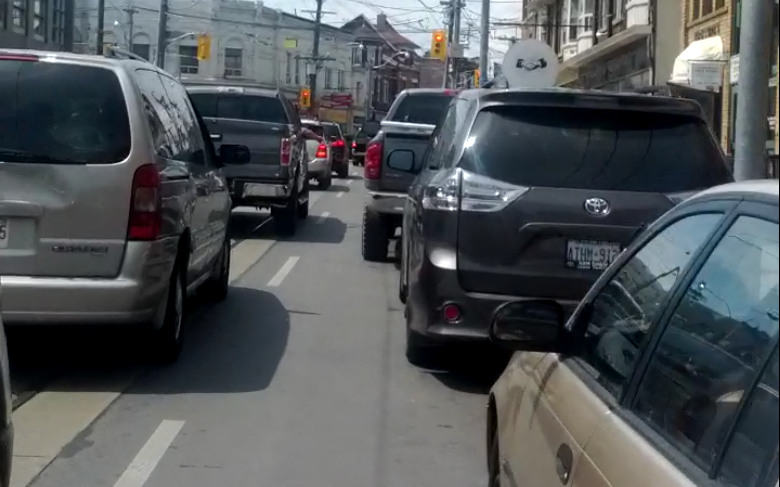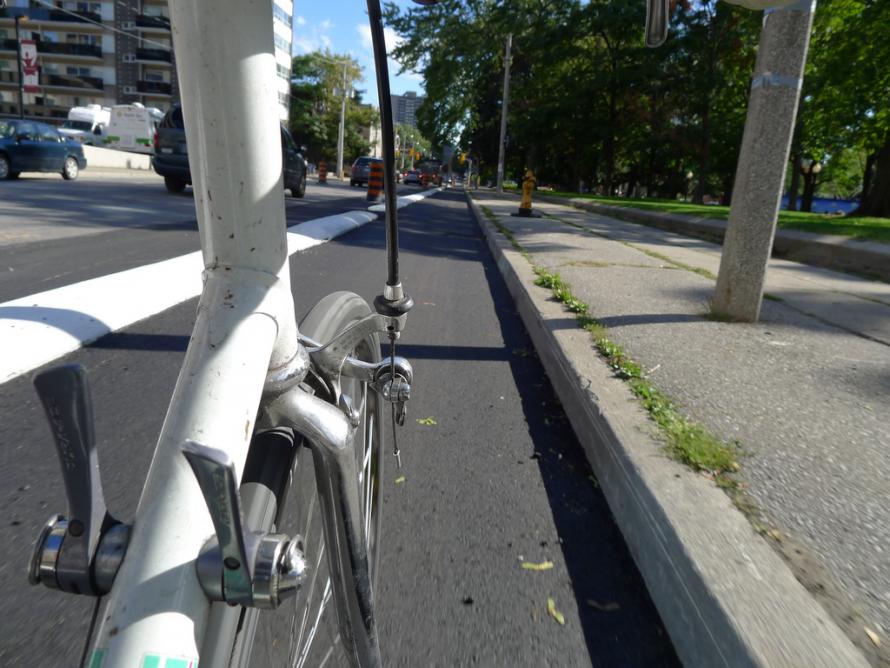Winter gets me thinking about how our streets are unforgiving. While riding on streets covered with fresh snow I sometimes imagine what would happen if I make a small mistake. Don't get me wrong, I don't mind slipping on snow. And Toronto winter streets are often clear of snow. When there is snow or ice, little slips sometimes happen but I just keep going. There's a difference in feelings of comfort, however, between slips on quiet side streets and slips on main arterial streets where we are typically forced into a narrow space between parked and moving cars. On arterial roads it feels like I'm grist in the mill, being ground into flour. Here we are an annoyance to drivers, but provide a valuable service of "friction" to calm traffic down. This seems to be our lot as Toronto cyclists.
Forgiving highways
The concept of "forgiving roads" first arose amongst traffic engineers as a way to design roads to forgive mistakes made by drivers. The reason our highways have wide shoulders and grassy areas with few obstacles, for example, is to allow wide enough clear zones to bring vehicles to controlled stops if they leave the road. If for someone were to accidentally drive off the road they would have lots of room to slow down. It was only natural for traffic engineers to start applying the forgiving highway principles to all rights-of-way. During the 1966 National Highway Safety hearings, national road safety expert Kenneth Stonex, who began his career at General Motors sought to apply the highway principles to urban streets. In this way North American urban environments began to be reshaped entirely for the automobile.
“What we must do is to operate the 90% or more of our surface streets just as we do our freeways… [converting] the surface highway and street network to freeway road and roadside conditions,” Stonex testified. It sounded logical at the time… and a great political solution, because the responsibility for fixing the problem once again fell on government, not the individual. We dove deep into the Forgiving Highway philosophy and still have not come up for air.
Why should forgiving roads only apply to auto drivers?
While highways have been designed so that drivers can maintain a high speed in relative safety, urban streets that are forgiving in this sense completely ignore the safety of everyone who isn't in a car. An urban street that accounted for people walking and cycling would require much different parameters. There is no way a pedestrian or a cyclist can compete with the speed of drivers. And yet urban streets are too complex to match highway driving. There are too many intersections with decisions to make to allow drivers to reach highway speeds. We are left in an awkward position where drivers complain of urban streets of being too congested and slow but engineers still have a predilection towards enabling drivers' ability to go fast. Drivers can still reach speeds - during the non-congested times of day - that are clearly unsafe. Cyclists are still forced to bike in the narrow space between parked cars and streetcar tracks, which only gets narrower and more dangerous in winter. Pedestrians are forced to scurry across crosswalks in the hope that drivers see them. That's not useful for anyone. The streets, instead, should be forgiving enough so that the most vulnerable person is able to safely use it, with a very low risk of death. Too much to ask?
The dark age of cycling advocacy is over
Cycling advocacy, however, has only recently begun to become more vocal in asking for an alternative to roads that prioritize high speed motor traffic. Cycling advocacy went through its own "dark age" when it was dominated by a ultra-libertarian and elitist ideology called "vehicular cycling" which put all the onus on cyclists to keep up with motor vehicles around them. All unfit, slow, young, old cyclists be damned. Harold Munn, who invented the term, defined vehicular cycling as "The task is to convince [cyclists] to operate their bicycles as they do their automobiles."
"Say what you will about vehicular cycling, but nobody is going to argue that it’s “forgiving," writes Bill Lindeke, in an excellent article on very same topic of forgiving streets for all. Lindeke read Bruce Epperson's interesting history of the vehicular cycling ideology (at least interesting for a bike nerd). Vehicular cycling was born in the United States in the 70s and 80s when the idea of creating bikeways had a stillbirth, leaving just university town Davis, California with a network of bikeways. The advocates and planners in Davis, Epperson describes as being a "third stream of egalitarians", alongside the vehicular cyclists and a middle stream of pragmatists.
Epperson writes that in Davis, the planners and advocates emphasized the vulnerable:
The third-streamers openly advocated policies that specifically targeted the weakest and most vulnerable bicyclists and involuntary users who rode strictly out of need, not choice. Together, these comprised cycling’s lowest common denominator, and for the third stream planners, they formed the yardstick by which to measure success or failure. If high-end recreational cyclists couldn’t live with their solutions, well, there were lots of other sports in the world they could turn to.
Lindeke asks the key questions that North American cities are only now beginning to ask:
Do you design bike lanes with the assumption that all the cyclists will be fast, efficient, well-trained, and “educated” about how to ride in traffic? Or do you design bike lanes for people who will move slowly, dawdle, and are perhaps younger or older or riding in groups? Do you design lanes for people who occasionally fall down?
Cycling advocacy in North America has made a sharp turn away from elitism of vehicular cycling and has started demanding cities designed for the vulnerable, the dawdlers, the old, the young. And some cities like New York, Portland, Chicago have heard the call. Toronto?



